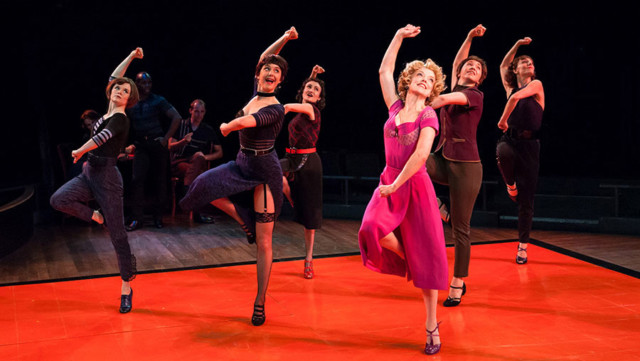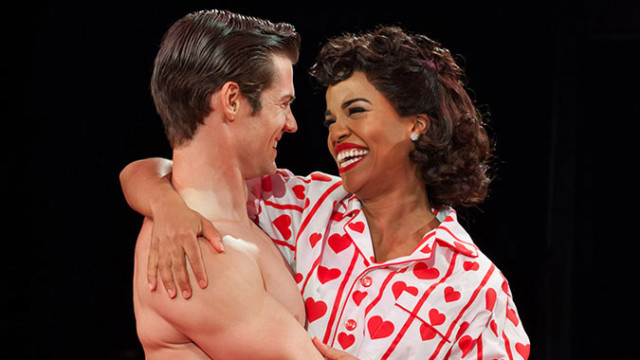The revival of “The Pajama Game” now playing at Washington D.C.’s Arena Stage is truly delightful.
Lisa Chiu is not the Culture Curmudgeon, she’s just filling in. She’s a digital producer at CGTN America. Her analysis represents her views alone.
From the live orchestra and thoughtful sets, lighting, and costumes, to the impressive singing and dancing of the talented cast, the musical is bathed in luscious color and movement that would make writers George Abbot and Richard Bissell proud to see their work live on unchanged.
But I’m really not sure it ought to.
Because aside from an inter-racial cast, nothing about the Arena Stage’s production reflects anything that’s transpired in the 63 years since the musical first premiered on Broadway in 1954.

(L-R) Bridget Riley (Doris), Casey Wenger-Schulman (Carmen), Alexandra Frohlinger (Sandra), Nancy Anderson (Gladys), Gabi Stapula (Mae) and Heidi Kershaw Quick (Virginia) in The Pajama Game, running October 27-December 24, 2017 at Arena Stage at the Mead Center for American Theater. Photo by Margot Schulman.
But before I go there — allow me to give credit where it is most definitely due.
“The Pajama Game” is a romance between two employees at an Iowa pajama factory, played with measured grace by Britney Coleman as Babe with the lovely Tim Rogan as Sid Sorokin. Their courtship is fast and passionate, and the duets are emotional, particularly “There Once Were a Man” — an unexpected hoedown song. (There’s never enough of those.)
But their relationship faces the ultimate test when the two are divided on labor issues at the factory. Babe is a union girl, while Sid is lower-wanna-be-upper management.
Hearts aside, “The Pajama Game” is also about the aspirations of the employees seeking better wages of seven and a half cents more an hour. From their opening scene, the choreographers and the cast of factory workers proved their applause in fast-paced songs and dances through swooshes of fabric and sewing machines on wheels, to a literal “Slow Down” number.

Blakely Slaybaugh (Prez), Britney Coleman (Babe Williams) and cast of The Pajama Game, running October 27-December 24, 2017 at Arena Stage at the Mead Center for American Theater. Photo by Margot Schulman.
Nancy Anderson who plays secretary Gladys stole the show — twice. First in the beatnik number “Steam Heat” and then in the cartoonishly sexy “Hernando’s Hideaway.” Never has the line “I’m out with friends,” been more perfectly delivered.
The production made optimal use of the four-sided auditorium at the Fitchlander theater with desks that dropped below stage and characters entering a secret bar from a hole in the floor. The lighting also seamlessly supported the mood — there’s even a moment when the shadows reflected on the floor mirrored the polka-dot pattern in some of the pajamas.
The ending is unsurprisingly tidy. Disputes are quickly settled, hearts are mended, and a cheerful “Seven-and-a-half Cents”, is sung.
Director Alan Paul’s revival has an Instagram-filter quality to it that makes the 1950s seem even more idyllic and removed from the present day.
And yet, that’s not what I wanted to feel at all.
I get that when theaters license productions it’s expected that they follow the script. If there are any changes they want to make, they need permission from the rights holder — in this case, Music Theatre International.
The Arena Stage opted not to make any material deviations from the script. I’m sure many audience members would support this, preferring that their revivals follow the familiar tone of the originals that people love and expect.
But to me, theater ought to be an opportunity to provide constant relevance, even to the creative work of past artists. “The Pajama Game” was entertaining — but I didn’t find it relevant.
The loving gaze that “The Pajama Game” gives to unions felt too incongruent with our present reality where the influence of the labor movement has declined so much over the years. In the 1950s, union membership was 35 percent, today it’s 10.7 percent. Some argue that the decline of the unions is the root cause of income inequality in the United States today.
The inter-racial casting, while at least more modern than the original, was also not addressed at all. I suppose we live in a post-racial society where it needn’t be, but then at least then make the poster for the play reflect that. Instead it features a white Babe, even though Coleman is black.

‘The Pajama Game” illustration by Paul Rogers
Imagine if they had taken it a step further and made the cast 36 percent Latino, 16 percent Asian, 9 percent black, and 35 percent male? — that would have reflected the current makeup of garment workers (Cut and sew apparel manufacturing) in the United States today.
Or they could have highlighted certain words with different intonations and emphasis. The theme song “Seven-and-a-half Cents” is actually quite bittersweet. Hearing it was one moment where I felt a timeless connection to the musical, as the characters shared their dreams of all the things they’d buy when they had more money. It could have been performed with so much more longing and poignancy, but instead was sung with glee.
Admittedly, there’s not a lot to work with since the musical itself isn’t particularly deep. In the book that it’s based on, author Richard Bissell (co-author of the musical) has the union getting the raise they sought — and retroactive pay — and then the two main characters both leave the factory for good.
In the musical, they get the raise — but no retroactive pay — and the couple remain in the factory happily even though their boss has been lying to them for six months. The musical feels like the 1950s version of Kendall Jenner’s tone-deaf Pepsi commercial.
Despite the limited script, I still longed for the production to show a little more tongue and cheek, to indicate that they were in on the conceit — but instead all I saw was a ‘50s premise acted to perfection.
“The Pajama Game” will be playing at the Arena Stage until Dec. 24, 2017.
 CGTN America
CGTN America
 (L-R) Tim Rogan (Sid Sorokin) and Britney Coleman (Babe Williams) in The Pajama Game, running October 27-December 24, 2017 at Arena Stage at the Mead Center for American Theater. Photo by Margot Schulman.
(L-R) Tim Rogan (Sid Sorokin) and Britney Coleman (Babe Williams) in The Pajama Game, running October 27-December 24, 2017 at Arena Stage at the Mead Center for American Theater. Photo by Margot Schulman.

